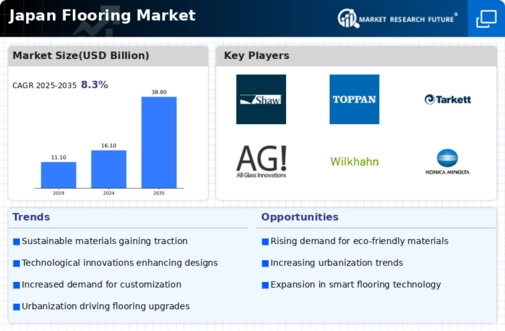Government Regulations and Standards
Government regulations and standards play a crucial role in shaping the flooring market in Japan. The government has implemented stringent guidelines regarding the use of materials and environmental sustainability, which influences manufacturers' practices. Compliance with these regulations often leads to increased production costs; however, it also drives innovation in developing sustainable flooring solutions. For instance, the introduction of regulations promoting the use of recycled materials is encouraging manufacturers to explore new avenues in product development. This regulatory landscape is expected to foster a competitive environment, pushing companies to enhance their offerings while adhering to safety and environmental standards, thereby impacting the overall market dynamics.
Urbanization and Housing Development
Urbanization in Japan is significantly impacting the flooring market. As more individuals migrate to urban areas, the demand for residential and commercial properties increases, subsequently driving the need for flooring solutions. The Japanese government has initiated various housing development projects, aiming to provide affordable housing options. This has led to a projected increase in flooring installations, particularly in metropolitan areas. According to recent data, the residential flooring segment is expected to account for over 60% of the total market share by 2026. This trend indicates that urbanization is a key driver, as it not only boosts demand but also encourages innovation in flooring materials and designs to cater to diverse consumer preferences.
Technological Advancements in Flooring
The flooring market in Japan is experiencing a notable shift due to technological advancements. Innovations such as improved manufacturing processes and enhanced materials are driving growth. For instance, the introduction of advanced laminate and vinyl flooring options has led to a surge in demand, as these products offer durability and aesthetic appeal. The market is projected to grow at a CAGR of approximately 5.2% from 2025 to 2030, indicating a robust expansion. Furthermore, the integration of technology in flooring solutions, such as moisture-resistant and soundproof materials, is appealing to consumers seeking high-performance products. This trend suggests that the flooring market is evolving to meet the needs of modern consumers, who prioritize both functionality and style.
Rising Consumer Awareness of Health and Safety
Consumer awareness regarding health and safety is becoming a pivotal driver in the flooring market. In Japan, there is a growing emphasis on indoor air quality and the use of non-toxic materials in flooring products. This shift is prompting manufacturers to develop eco-friendly and safe flooring options, such as bamboo and cork, which are perceived as healthier alternatives. The market for such sustainable flooring solutions is anticipated to grow by approximately 7% annually, reflecting a significant shift in consumer preferences. As awareness continues to rise, the flooring market is likely to adapt, focusing on products that not only enhance aesthetics but also promote a healthier living environment.
Shifts in Consumer Preferences and Lifestyle Changes
Shifts in consumer preferences and lifestyle changes are significantly influencing the flooring market in Japan. As lifestyles evolve, there is a noticeable trend towards multifunctional spaces within homes and offices, prompting consumers to seek versatile flooring options. The demand for easy-to-maintain and aesthetically pleasing flooring solutions is on the rise, with products like luxury vinyl tiles gaining popularity. Market data indicates that the demand for such products could increase by 8% over the next few years. Additionally, the growing trend of remote work is leading to increased investments in home renovations, further driving the need for innovative flooring solutions. This suggests that the flooring market is adapting to meet the changing needs of consumers.


















Leave a Comment